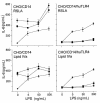Toll-like receptor 4 imparts ligand-specific recognition of bacterial lipopolysaccharide
- PMID: 10683379
- PMCID: PMC289161
- DOI: 10.1172/JCI8541
Toll-like receptor 4 imparts ligand-specific recognition of bacterial lipopolysaccharide
Abstract
Lipopolysaccharide (LPS) is the main inducer of shock and death in Gram-negative sepsis. Recent evidence suggests that LPS-induced signal transduction begins with CD14-mediated activation of 1 or more Toll-like receptors (TLRs). The lipid A analogues lipid IVa and Rhodobacter sphaeroides lipid A (RSLA) exhibit an uncommon species-specific pharmacology. Both compounds inhibit the effects of LPS in human cells but display LPS-mimetic activity in hamster cells. We transfected human TLR4 or human TLR2 into hamster fibroblasts to determine if either of these LPS signal transducers is responsible for the species-specific pharmacology. RSLA and lipid IVa strongly induced NF-kappaB activity and IL-6 release in Chinese hamster ovary fibroblasts expressing CD14 (CHO/CD14), but these compounds antagonized LPS antagonists in CHO/CD14 fibroblasts that overexpressed human TLR4. No such antagonism occurred in cells overexpressing human TLR2. We cloned TLR4 from hamster macrophages and found that human THP-1 cells expressing the hamster TLR4 responded to lipid IVa as an LPS mimetic, as if they were hamster in origin. Hence, cells heterologously overexpressing TLR4 from different species acquired a pharmacological phenotype with respect to recognition of lipid A substructures that corresponded to the species from which the TLR4 transgene originated. These data suggest that TLR4 is the central lipid A-recognition protein in the LPS receptor complex.
Figures





References
-
- Sands KE, et al. Epidemiology of sepsis syndrome in 8 academic medical centers. Academic Medical Center Consortium Sepsis Project Working Group. JAMA. 1997;278:234–240. - PubMed
-
- Raetz CR, et al. Gram-negative endotoxin: an extraordinary lipid with profound effects on eukaryotic signal transduction. FASEB J. 1991;5:2652–2660. - PubMed
-
- Fenton MJ, Golenbock DT. LPS-binding proteins and receptors. J Leukoc Biol. 1998;64:25–32. - PubMed
-
- Kitchens RL, Munford RS. Enzymatically deacylated lipopolysaccharide (LPS) can antagonize LPS at multiple sites in the LPS recognition pathway. J Biol Chem. 1995;270:9904–9910. - PubMed
Publication types
MeSH terms
Substances
Grants and funding
LinkOut - more resources
Full Text Sources
Other Literature Sources
Research Materials

